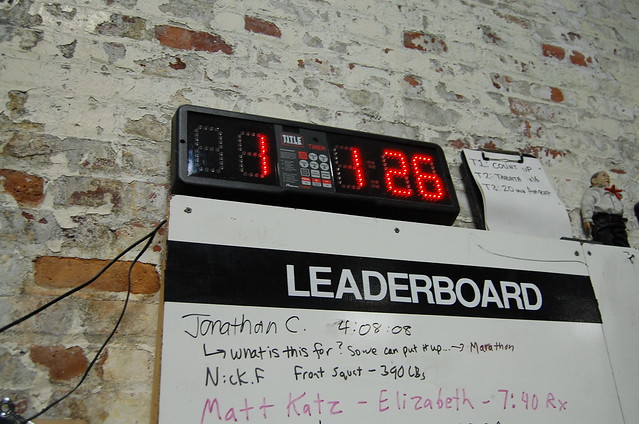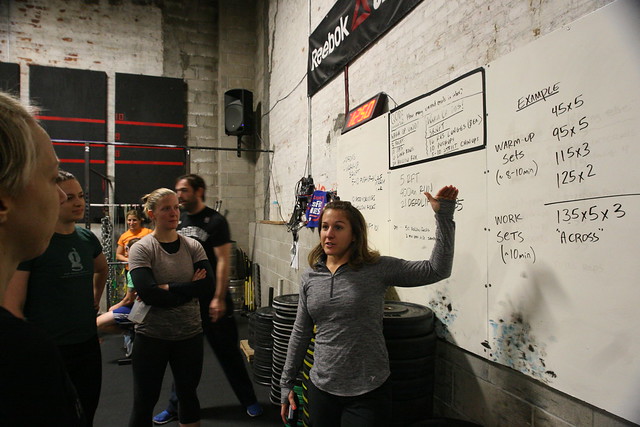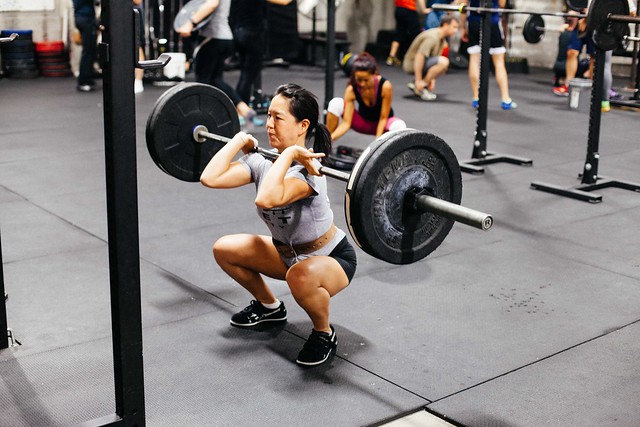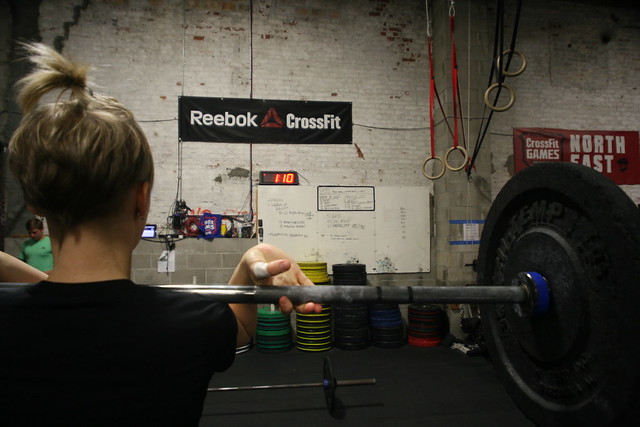
As mentioned in a previous article, “Starting Classes with Introductions,” quite a lot of movement and coaching needs to fit into a 60-minute CrossFit group class. A typical class might include a compilation of three to five segments involving barbell warm-ups, reviews at the white board, WODs, lifting, skill development, and cool downs, etc. Especially as your affiliate grows, you'll need to have consistent and effective time management strategies to get large volumes of people through each class in a clear and practical way. At CFSBK, we constantly use time stamps—by which I mean specific, pre-set amounts of time—to achieve our planned programming within the hour.
Below I'll discuss some different class segments we typically use, how long each segment takes, and how we manage the segment’s time limits. As you'll see, we're heavy users of wall-mounted digital timers. If you're only using timers to measure WOD finish times, you're totally under-using them. We have four digital clocks in our gym—one always displays the actual time, and our coaches use the others to communicate time stamps and run WODs. Having multiple clocks is also helpful when running more than just Group Classes at any given hour.
Intros and Movement Prep (3-10 Minutes)
This portion of a Group Class is simply managed by the coach keeping their eye on the clock set to the actual time and adjusting according to how long the movements take to execute. On days when the overall class objectives are a little lighter, this segment can be extended and movement prep can be more specialized. Starting class exactly on time is critical to keeping an accurate measure of how long movement prep is taking.
Standardized Warm-Ups (8-10 minutes) Are you getting the most out of these?
Are you getting the most out of these?
Depending on our programming, we often allot time for standardized warm-ups. These vary through training cycles but usually resemble the CrossFit warm-up and consist of three movements performed for three rounds, not for time. Once Intros are done, we start one of the wall timers to indicate the warm-up has started, so people know exactly how much time they have left before we bring it back to the whiteboard and discuss the next segment. As long as you're programming simple standardized warm-ups, everyone should be able to finish three rounds in less than 10 minutes. If members finish early, they're encouraged to get some water, do some movement prep, or change shoes—anything that would further prepare them for the movement or WOD ahead. Enforce whatever cap you use and provide a one-minute warning to let stragglers know to try and finish up. It's okay if people don’t always finish—we advise three rounds or 10 minutes, whichever comes first. The point is that the class is moving forward with the next segment regardless.
(In a future article, I'll discuss in more detail how we organize and manage these warm-ups.)
White Board Reviews (1-5 minutes)
This usually only requires a couple minutes, sometimes less, sometimes more. In addition to briefing the class about the logistics of how the following segment will run—including scaling options and any points of performance to consider—this is a great time to communicate how class members should manage their own time while lifting or doing skill work. For example, prior to a lifting segment, coaches can remind the class to be done with warm-up sets by the 8-10 minute mark and to get into their work sets so they have enough time to finish at the 20-minute mark. Coach Melo talks time management before a lifting segment.
Coach Melo talks time management before a lifting segment.
Synchronized Reviews for Olympic Lifting and Gymnastics (5-15 Minutes)
When teaching the Olympic lifts or more nuanced gymnastic movements, you'll need to take the class through synchronized skill work as a group in order to effectively communicate points of performance. The time required for this varies drastically depending on what you're teaching and the size of the class. A simple push jerk review might take five minutes with a medium-sized class, while power snatches with a large class can require up to three times as long to cover properly. Again, these time requirements are managed by the coach who keeps his or her eye on the actual clock. We might start a review at 18 minutes after the hour and know that we need to be done by the 30-minute mark to have enough time for the rest of class.
After everyone has been paired up at the white board (according to barbell weight) and assigned racks, we start a wall timer and enter the lifting segment. The slow lifts (squats, deadlifts, and presses) are usually allotted 15-20 minutes, since they generally don't require the synchronized class reviews we do for Olympic lifts (the snatch and clean and jerk). We’ve found that 20 minutes is ample time for classes to move through their warm-up and work sets with slow lifts. With Olympic lifts, we take 12-15 minutes for work sets after the synchronized reviews.
WODs (Varies)
Obviously, these can vary dramatically based on what's programmed. We generally think it's a good practice to use time caps on most or all WODs. Not only does it give your members another tool for figuring out how to scale appropriately, but it keeps things running on time, especially if you're using multiple heats to get larger classes through the workout.
NFT Assistance Work (10-20 Minutes)
We also occasionally program Not For Time (NFT) assistance work in lieu of a WOD or lifting segment. A typical example is something such as:
Four Rounds NFT of:
8 Heavy dumbbell presses
8 Strict toes-to-bars
12 Heavy kettlebell swings
We execute NFT work exactly like standardized warm-ups, meaning we set a cap and use the wall timers to communicate and organize time during the class.
A Typical Class
Any CrossFitter knows that the shape and feel of their training sessions can vary greatly. The time stamp template we use changes every day based on what's programmed. Here is an outline for how class time might be managed:
Intros: about 3 minutes Mare knows exacly how long she has to get her front squats in.
Mare knows exacly how long she has to get her front squats in.
Standardized warm-up: 8 minutes
White board review: about 2 minutes
Lift time: 20 minutes
White board review: about 2 minutes
WOD: 15-minute total window to execute, 10-minute cap on WOD
Consistency and Compliance
Again, we remind each class how much time remains at different points throughout each segment, so athletes can adjust accordingly. Without a clear indication of when segments need to be completed, lots of time will be wasted waiting for people to finish. This lack of time management can easily cut into valuable class time and create a dead space in classes for those who finish early or on time. Both managing time well and starting and ending classes on time demonstrate good planning and most importantly, respect for your members.
As you develop and incorporate your own time management tactics, you'll notice that members will quickly assimilate the class flow and will work with you to make each segment run efficiently. You can't expect people to read your mind, so communicate clearly, employ consistent tools and language, and you'll find that even huge classes can be run very effectively.
________________________
What other strategies have you found for managing timing in Group Classes?
